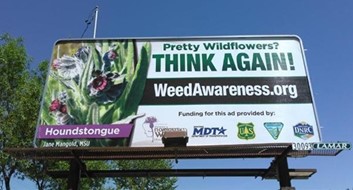Noxious Weed Views and Behaviors after 25 Years of Education and Outreach
Introduction

Photo by Montana Noxious Weed Education Campaign
Increasing the general public’s knowledge of noxious weeds is believed to be an important element of successful management, and many resources have been dedicated to this end. However, measuring the impact of noxious weed education and outreach efforts is limited.
In 1994 a general population survey was conducted via telephone to evaluate Montana residents’ knowledge about noxious weeds. Survey results suggested more education and outreach was needed, and the Montana Noxious Weed Education Campaign (hereafter referred to as “The Campaign”) was formed. The Campaign, supported by multiple federal, state, and non-governmental partners, educates the people of Montana about the economic and environmental impacts of noxious weeds and encourages participation in management. Activities include presentations, publications, trade show booths, radio and television ads, billboards, social media, plus others. The goal of this study was to evaluate noxious weed views and behaviors of Montanans after 20+ years of education and outreach.
Methods
We implemented a mail-based survey in spring 2019 that included 29 questions on topics such as knowledge and perception of noxious weeds, engagement in a variety of outdoor activities, behaviors associated with preventing noxious weed spread, sources of information for learning about noxious weeds, and self-perception of noxious weed knowledge. Whenever possible, we asked questions similar to the 1994 telephone survey. Our survey had a response rate of 18%, with 830 responses from 4,582 valid mailing addresses. Different areas of the state were equally represented across our respondents, but respondents were generally older and represented by more males than the general adult population. Therefore, we weighted responses to ensure age and gender distributions in the data match those of the general adult population in Montana.
Results
Just under half (48%) of respondents report “little” or “no” knowledge about noxious weeds, suggesting room for improvement. However, this is a 19-point improvement since 1994 when 67% reported “little” or “no” knowledge. Two-thirds of respondents indicate noxious weeds are a “serious” or “very serious” problem and recognize a wide suite of impacts associated with noxious weeds. Most respondents (61%) identify humans as contributing “a lot” to noxious weed spread, which is different than the 1994 survey in which wind, livestock, and wildlife were common answers and about one-third of respondents provided answers that were not recognized by weed professionals as common vectors. Self-reported behaviors to prevent the spread of noxious weeds (e.g., washing vehicles and gear, using noxious weed seed-free forage, disposing of seeds stuck to clothing or pets in trash receptacle) have increased over time. A variety of information delivery methods had similar levels of effectiveness, in contrast to 1994 when TV, newspaper, and radio were identified as best. Most importantly, respondents who have seen educational materials are more likely to view noxious weeds as a serious problem and to engage in behaviors to stop their spread, suggesting noxious weed education is valuable for management overall. We conclude that future efforts should continue with multi-faceted delivery of information that is action oriented. For more details, read the entire article by Mangold, Frame-Martin, and Raile (2021).
Further Information
For more information about this month's weed post, contact Extension Invasive Plant Specialist Jane Mangold. Past posts are available in the Monthly Weed Post Directory.
This weed post is also available as a printable PDF (543KB).
